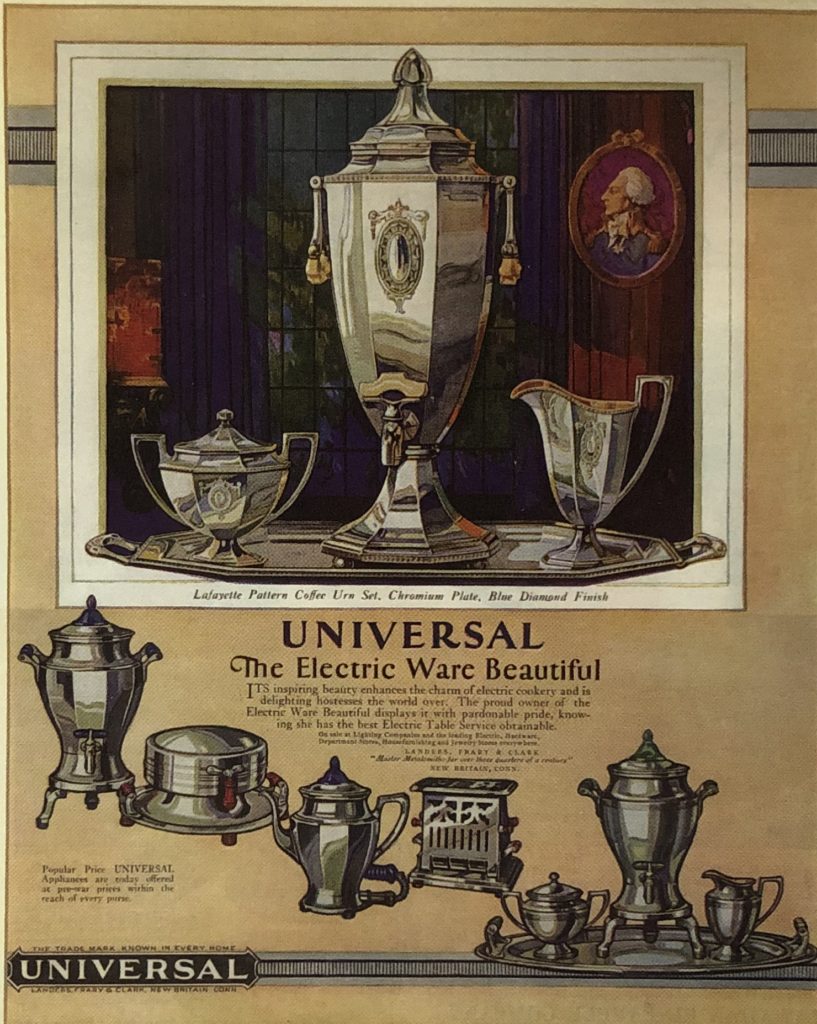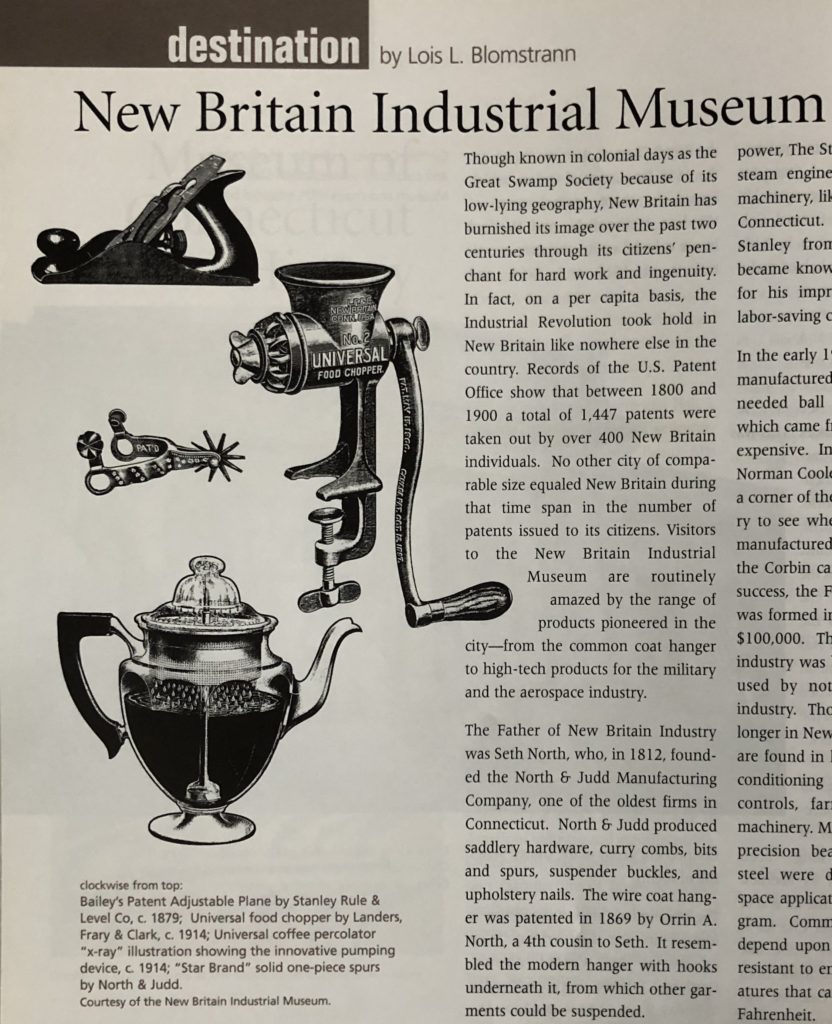(c) Connecticut Explored Inc. Spring 2005
Subscribe/Buy the Issue!
Though known in colonial days as the Great Swamp Society because of its low-lying geography, New Britain has burnished its image over the past two centuries through its citizens’ penchant for hard work and ingenuity. In fact, on a per capital basis, the Industrial Revolution took hold in New Britain like nowhere else in the country. Records of the U.S. Patent Office show that between 1800 and 1900 a total of 1,447 patents were taken out by over 400 New Britain individuals. No other city of comparable size equaled New Britain during that time span in the number of patents issued to its citizens. Visitors to the New Britain Industrial Museum are routinely amazed by the range of products pioneered in the city – from the common coat hanger to high-tech products for the military and the aerospace industry.
The Father of New Britain Industry was Seth North, who in 1812, founded the North & Judd Manufacturing Company, one of the oldest firms in Connecticut. North & Judd produced saddlery hardware, curry combs, bits and spurs, suspender buckles, and upholstery nails. The wire coat hanger was patented in 1869 by Orrin A. North, a 4th cousin to Seth. It resembled the modern hanger with hooks underneath it, from which other garments could be suspended.
New Britain’s next major manufacturing firm was founded in 1843 by Frederick Stanley. Since New Britain has no rivers or streams to produce power. The Stanley Works relied on a steam engine to drive the factory’s machinery, likely the first such use in Connecticut. Justus Traut worked for Stanley from 1850 to 1904 and became known as the “Patent King” for his improvement of time and labor-saving carpenter tools.
In the early 1900s the Corbin car was manufactured in New Britain. Cars needed ball bearings, the best of which came from Germany and were expensive. In 1909 Howard Hart and Norman Cooley began experiments in a corner of their hot-air register factory to see whether bearings could be manufactured locally, and although the Corbin car was not a commercial success, the Fafnir Bearing Company was formed in 1911 with a capital of $100,000. Thus, a giant Connecticut industry was born, making a product used by not just the automotive industry. Though the company is no longer in New Britain, Fafnir bearings are found in heating, cooling and air conditioning systems, pipeline valve controls, farm and road building machinery. Miniature and instrument precision bearings of special alloy steel were designed especially for space applications in the missile program. Commercial aircrafts, as well, depend upon bearings that are resistant to engine operating temperatures that can exceed 2,000 degrees Fahrenheit. Landers, Frary & Clark began making items for the home before electricity became widely available. Their “Universal” food chopper was a first and sold all over the world. The company also produced coffee grinders, and so it was natural that it would develop a device to make coffee. In 1905 they produced a percolator. Rather than putting the ground coffee directly into the water and letting it boil they having to strain it, the coffee was put into a basket that had a stem attached to it. When the water was hot enough, it rose up through the stem and flowed over the coffee, filtering it through the basket. This was a revolutionary innovation. In 1908 the first electrical socket for a percolator was patented by Landers, and in 1912 the company began the manufacture of the electric percolator. In 1941, Landers developed the world’s first automatic coffeemaker under the trade name “Universal.” It was timed by thermostatic control so that it always brewed coffee to the preferred strength.
Landers, Frary & Clark began making items for the home before electricity became widely available. Their “Universal” food chopper was a first and sold all over the world. The company also produced coffee grinders, and so it was natural that it would develop a device to make coffee. In 1905 they produced a percolator. Rather than putting the ground coffee directly into the water and letting it boil they having to strain it, the coffee was put into a basket that had a stem attached to it. When the water was hot enough, it rose up through the stem and flowed over the coffee, filtering it through the basket. This was a revolutionary innovation. In 1908 the first electrical socket for a percolator was patented by Landers, and in 1912 the company began the manufacture of the electric percolator. In 1941, Landers developed the world’s first automatic coffeemaker under the trade name “Universal.” It was timed by thermostatic control so that it always brewed coffee to the preferred strength.
In an effort to preserve New Britain’s rich industrial history, The New Britain Industrial Museum was founded in 1995. The museum seeks to educated and inspire visitors with the vision, creativity, and work ethic of New Britain’s innovators. Items made in New Britain over the past 200 years are on exhibit in the I.T.B.D. (Institute of Technology and Business Development) Building of Central Connecticut State University at 185 Main Street, New Britain. Also on exhibit are products currently being made in the city as well as prototypes not yet marketed, which have come from the incubator business sponsored by the University. The museum is open Monday through Friday from 2:00 P.M. to 5:00 P.M., Wednesday from noon to 5:00 P.M. Admission is free and the museum is handicapped accessible. To request a brochure our tour, call (860) 832-8654 or visit www.nbim.org.
Lois L. Blomstrann is one of the founders of the New Britain Industrial Museum and currently serves on the museum’s board of directors. She wrote “Manufacturing for the War Effort” in the 2003 Nov/Dec/Jan 2004 issue.
Explore!
“Manufacturing for the War Effort,” 2003 Nov/Dec/Jan 2004
“Connecticut’s Small Appliance Revolution,” Summer 2017
Read more stories about products made and invented in Connecticut and labor history on our TOPICS pages.

